Nigella Sativa: [Planting, Care, Irrigation, Pests and Characteristics]
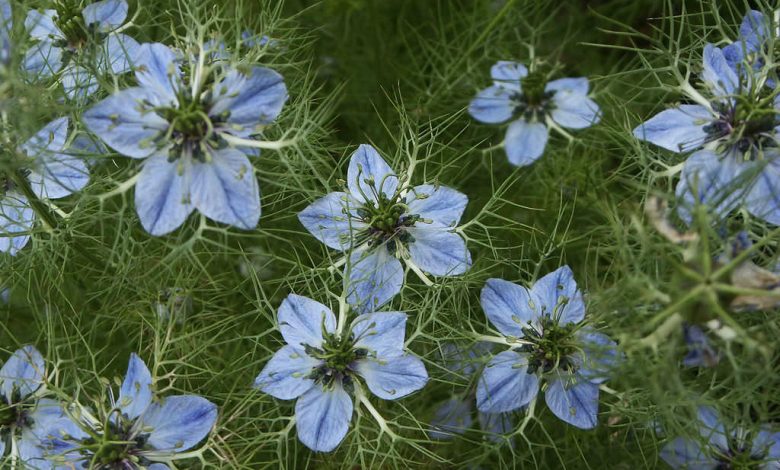
Important points when planting Nigella Sativa
- When? The growing season of its famous seed must be done at the end of spring.
- Where? Preferably, it should be grown in warm weather environments. They occur quite easily, but preferably in places with great sun exposure.
- How do we prepare the land? Soil preparation with alkaline pH is essential. It thrives in clayey or sandy soils, without waterlogging.
- How do we sow? At the end of spring, sow by seed, using seedbeds prepared in winter. When seedlings grow to a height of between 30-40 cm, they are transferred to the garden.
- How do we pay? With organic fertilizer, which lavishes many nutrients.
- When is the harvest ready? In 10-11 months it completes the complete cycle of germination, growth and development of thousands of fruits that mature and give us seeds of great culinary and medicinal value.
- Ideal temperature? The daytime ideal should be between 22ºC to 26ºC and a little more. The night ranges between 18ºC to 24ºC. Below 5ºC it will suffer a bit.
- How do we water? It can be watered 3-4 times a week in summer and only 2 times a week the rest of the year. It does not support puddles.
- Diseases and pests? It is quite resistant, but excess water can damage it a lot and rot its roots and fungi reproduce.
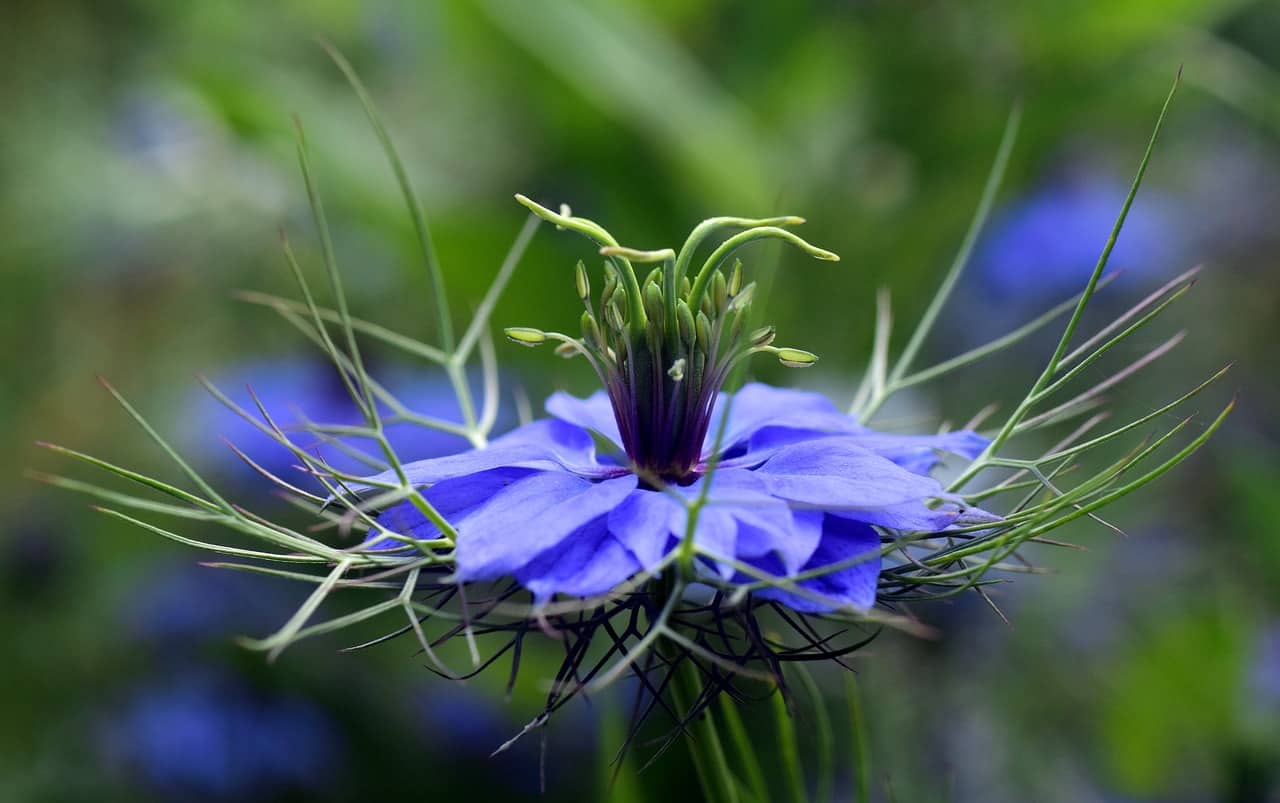
What is Nigella sativa? Characteristic
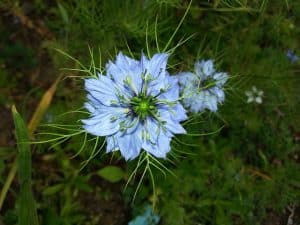 A very unique herbaceous plant is Nigella sativa, also known by the common names of black cumin, abésoda or ajenuz.
A very unique herbaceous plant is Nigella sativa, also known by the common names of black cumin, abésoda or ajenuz.
It belongs to the Ranunculaceae family, it reaches a maximum height of 60 centimeters and its appearance is grayish green and it has an unconventional whitish or slightly purple flower with sepals larger or more striking than the petals.
Its fruit is encapsulated and to extract its seeds you have to wait for it to ripen.
Its flowering period reaches its splendor in spring and even reaches the beginning of summer. Although there are species that bloom in the fall.
It is native to Turkey and Iraq, in western Asia, with more than 2,500 fully identified species, but its original variant comes from Egypt. It can be seen today from the Mediterranean to Central Asia. It is seen from Spain, although timidly, to the point of abounding in India.
Medicinal properties of Nigella sativa
Since ancient times, it has been considered a medicinal plant with antifungal and antibacterial qualities, with black seeds used even as a condiment (similar to pepper) or as a powerful bronchodilator to treat respiratory problems in asthmatics.
Its anti-inflammatory, moisturizing and regenerating property of the skin comes from the thymoquinone component, a powerful natural antiseptic used as an essential oil.
Eliminates uric acid, fights jaundice and increases body heat.
Where should we plant Nigella sativa?
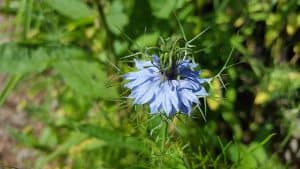 This plant adapts perfectly well to the Mediterranean climate, even though it is of Asian origin, so it can withstand hot summers without any problem and cold periods, although it does not like frost. A minimum of 5ºC is what it resists in winters.
This plant adapts perfectly well to the Mediterranean climate, even though it is of Asian origin, so it can withstand hot summers without any problem and cold periods, although it does not like frost. A minimum of 5ºC is what it resists in winters.
That is why it prefers sunny days, with exposures of about 6 hours it will be more than enough, they withstand sunlight quite well.
In fact, today it has managed to spread quite easily throughout the world, since it adapts to almost any type of soil.
When should it be cultivated?
In the case of sowing and multiplication of Nigella sativa, this must be done with seeds, which appear after flowering is a fact, at the end of spring.
The seeds are placed inside a pod and are very aromatic, similar in smell to nutmeg. That is why they are also called false cumin. These are removed by allowing the sheathed capsule to dry, which protects them from the elements.
The appropriate thing is to cultivate them in seedbeds, when the winter season arrives and then move them to the open ground, to the garden where they can fully develop until they reach a height of between 30 to 40 centimeters, or perhaps a little more.
Did you know…?A curious fact about this seed is that it was used even in the tombs of the Pharaohs in Ancient Egypt and Cleopatra used its essential oil to keep its beauty intact.
Its growth cycle is quite fast, because it only takes 10-11 months to germinate, grow and give away thousands of seeds for use in the kitchen and for medicinal purposes.
How do we prepare the land?
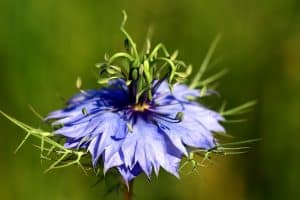 The land must have a fundamental characteristic: alkaline soil is the most convenient for black cumin. An alkaline pH suits it very well, but acidic or neutral pH soils also suit it well, so much so that this plant can still grow in sandy and clay soils.
The land must have a fundamental characteristic: alkaline soil is the most convenient for black cumin. An alkaline pH suits it very well, but acidic or neutral pH soils also suit it well, so much so that this plant can still grow in sandy and clay soils.
A well-drained soil is very important for this herbaceous plant, because its roots are actually somewhat delicate and do not support excessive humidity, so watering must be carried out spaced out, taking great care not to drown it.
A preparation of organic nutrients will help it a lot to grow healthily, since it favors the growth of strong roots, as well as the production of its essential oils of high commercial value.
How to plant Nigella Sativa step by step?
If you manage to buy or access some black cumin seeds, we recommend the following tips to take advantage of its benefits:
- Prepare a pot with a universal growing medium containing 35% perlite to ensure good water drainage.
- If you prefer to plant them in a garden, remember that Nigella sativa is not very demanding, but it avoids waterlogging. That is why very porous soils favor it.
- It is recommended, once the seeds have been sown at an estimated depth of about 4 centimeters, taking care of a distance between seed and seed of about 5 centimeters. The ideal is to do this in spring, in seedbeds or directly in the garden.
- It is necessary to water 3-4 times a week in the summer season, because both the plant and the seed need to stay hydrated and the rest of the year it can be reduced to 2 times a week.
- Likewise, the application of a powerful organic fertilizer is recommended to keep it well nourished. Guano is ideal to help her .
- The pruning of wilted leaves and flowers is essential to maintain the health of the plant.
What care does Nigella Sativa need?
- Abundant natural light is highly recommended. It needs a lot of sunlight.
- It does not require large daily waterings. Doing it twice a week will be more than enough for her to grow healthy, because she does not tolerate waterlogging.
- It requires the help of well-drained, clayey and sandy soils, which are its favorite, although it has managed to adapt very well to Mediterranean terrain.
- It is advisable to lavish it with a good extra dose of fertilizer during the flowering season, between spring and early summer.
What pests and diseases does it have?
It does not usually suffer serious problems with insect attacks, but it does suffer tremendously when it is subjected to intensive irrigation, because its roots will tend to rot and the flowering cycle will be impaired.
Fungi can also attack, but in general terms it is a fairly resistant and durable annual plant.

![Photo of Tajinaste Rojo: [Characteristics, Habitat, Reproduction and Uses]](https://www.complete-gardening.com/wp-content/uploads/2022/08/tajinaste-rojo-characteristics-habitat-reproduction-and-uses-390x220.jpg)

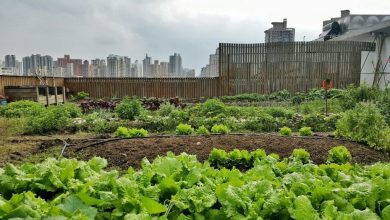
![Photo of Vine Diseases: [Characteristics, Detection and Effects]](https://www.complete-gardening.com/wp-content/uploads/2022/08/vine-diseases-characteristics-detection-and-effects-390x220.jpg)